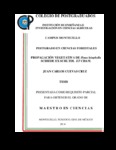| dc.contributor.author | Cuevas Cruz, Juan Carlos | |
| dc.creator | CUEVAS CRUZ, JUAN CARLOS; 442606 | |
| dc.date.accessioned | 2014-07-31T00:08:51Z | |
| dc.date.available | 2014-07-31T00:08:51Z | |
| dc.date.issued | 2014 | |
| dc.identifier.uri | http://hdl.handle.net/10521/2347 | |
| dc.description | Tesis (Maestría en Ciencias, especialista Forestal).- Colegio de Postgraduados, 2014. | en_US |
| dc.description.abstract | Se probó el enraizado de estacas, acodo aéreo e injerto para clonar genotipos de un huerto semillero de P. leiophylla, putativamente resistentes al ataque de Dendroctonus sp. y Toumeyella pinicola Ferris. y que además muestran las mejores características fenotipicas. Con el primer método se clonó a la progenie, mientras que los otros métodos se desarrollaron para clonar a los árboles madre. En el enraizado de estacas se evaluó el efecto del substrato, tipo de estaca y concentración de ácido indolbutírico (AIB). Se utilizaron dos tipos de substrato (100 % de agrolita vs. una mezcla de turba-agrolita-vermiculita 1:1:1), dos tipos de estaca (apicales vs. basales) y dos concentraciones de AIB (0 vs. 10, 000 ppm). En el acodo aéreo se evaluó el efecto de cuatro concentraciones de AIB (0, 3000, 5000 y 10000 ppm), mientras que el efecto del árbol donante y tipo de púa fueron los factores considerados en el injerto. En el enraizado de estacas, usando estacas basales es 3.5 veces más probable que el enraizamiento sea inducido que con apicales, el porcentaje de enraizado entre el tratamiento de mayor y menor respuesta fue de 45.3 y 8.6 %, respectivamente. El uso de agrolita y la aplicación de AIB favorecieron un mayor número de raíces. Para el acodo aéreo utilizando las concentraciones de 3000, 5000 y 10000 ppm de AIB es 1.6, 3.2 y 12 veces más probable que el enraizamiento sea inducido que con la concentración de 0 ppm. En la propagación por injerto no fue posible realizar un análisis estadístico de los factores bajo estudio; las condiciones ambientales y la calidad de los portainjertos limitaron el prendimiento. _______________ ASEXUAL PROPAGATION OF Pinus leiophylla SCHIEDE EX SCHLTDL. ET CHAM. ABSTRACT: In order to clone genotypes of a seed orchard of P. leiophylla with the better phenotypic characteristics and resistant putatively to Dendroctonus sp. and Toumeyella pinicola Ferris., rooting cuttings, air layering and grafting for vegetative propagation of genotypes of interest was performed. With the first method cloning propagation was for the offspring, whereas the other methods were developed for progenitors. In the rooted cuttings the effect of substrate, type of cutting and indolebutyric acid (IBA) concentration was evaluated. Two types of substrate (100% of perlite vs. mix of peat, perlite, vermiculite 1:1:1), two types of cuttings (apical vs. basal) and two concentrations of IBA (0 vs. 10, 000 ppm). In air layering effect of four concentrations of IBA (0, 3000, 5000 and 10000 ppm) was evaluated, while the effect of the donor tree and type of scion were the factors considered in the graft. The rooted cuttings using basal cuttings is 3.5 times more likely to be induced rooting than by apical cutting; rooting percentage between the highest and lowest treatment response was 45.3 and 8.6 %, respectively. The use of perlite and implementation of IBA favored a greater number of roots. For air layering using concentrations of 3000, 5000 and 10000 ppm IBA is 1.6, 3.2 and 12 times more likely to be induced rooting with the concentration of 0 ppm. In propagation by grafting was not possible to perform a statistical analysis of the factors under study; environmental conditions and the quality of rootstocks limited engraftment. | en_US |
| dc.description.sponsorship | Consejo Nacional de Ciencia y Tecnología (CONACYT). | en_US |
| dc.language.iso | spa | en_US |
| dc.rights.uri | http://creativecommons.org/licenses/by-nc-nd/4.0 | |
| dc.subject | Enraizado de estacas | en_US |
| dc.subject | Acodo aéreo | en_US |
| dc.subject | Injerto | en_US |
| dc.subject | Auxina | en_US |
| dc.subject | Raíces | en_US |
| dc.subject | Rooting cuttings | en_US |
| dc.subject | Air layering | en_US |
| dc.subject | Graft | en_US |
| dc.subject | Auxin | en_US |
| dc.subject | Roots | en_US |
| dc.subject | Ciencias Forestales | en_US |
| dc.subject | Maestría | en_US |
| dc.title | Propagación vegetativa de Pinus leiophylla Schiede Ex Schltdl Et Cham | en_US |
| dc.type | Tesis | en_US |
| Tesis.contributor.advisor | Jasso Mata, Jesús | |
| Tesis.contributor.advisor | Jiménez Casas, Marcos | |
| Tesis.contributor.advisor | López Uptón, Javier | |
| Tesis.contributor.advisor | Rebolledo Camacho, Virginia | |
| Tesis.date.submitted | 2014 | |
| Tesis.date.accesioned | 2014-07-15 | |
| Tesis.date.available | 2014-07-30 | |
| Tesis.format.mimetype | pdf | en_US |
| Tesis.format.extent | 1,717 KB | en_US |
| Tesis.subject.nal | Pinus | en_US |
| Tesis.subject.nal | Dendroctonus | en_US |
| Tesis.subject.nal | Toumeyella pini | en_US |
| Tesis.subject.nal | Portainjertos | en_US |
| Tesis.subject.nal | Rootstocks | en_US |
| Tesis.subject.nal | Genotipos | en_US |
| Tesis.subject.nal | Genotypes | en_US |
| Tesis.rights | Acceso abierto | en_US |
| Articulos.subject.classification | Propagación vegetativa | en_US |
| dc.type.conacyt | masterThesis | |
| dc.identificator | 5 | |
| dc.contributor.director | JASSO MATA, JESUS; 9567 | |


